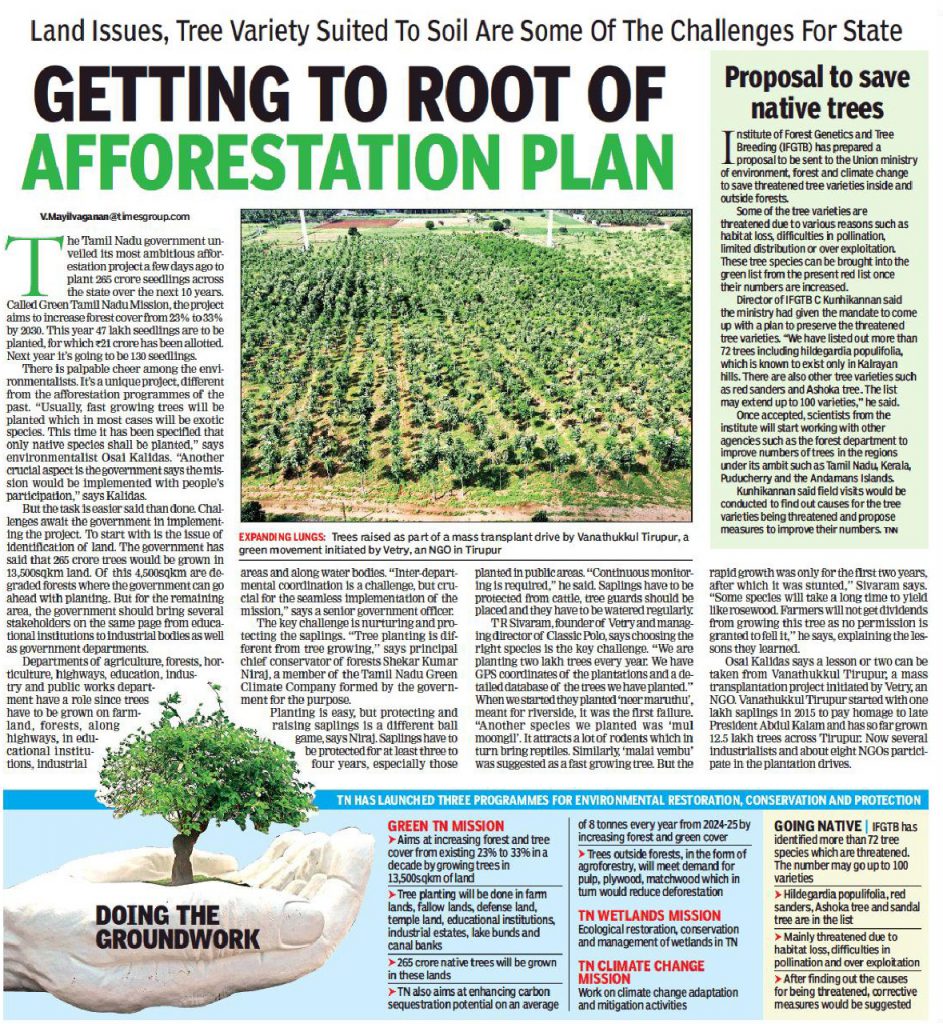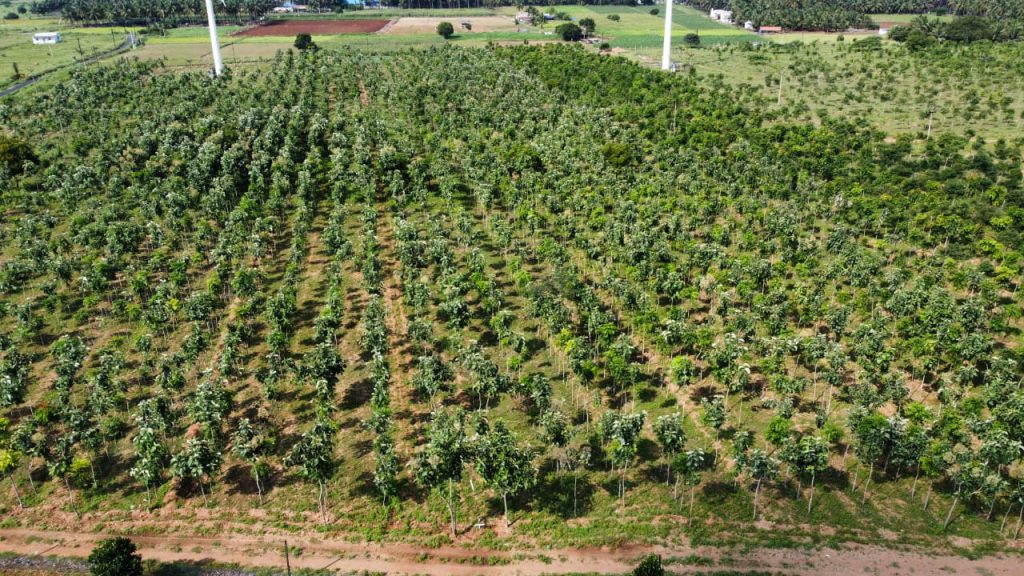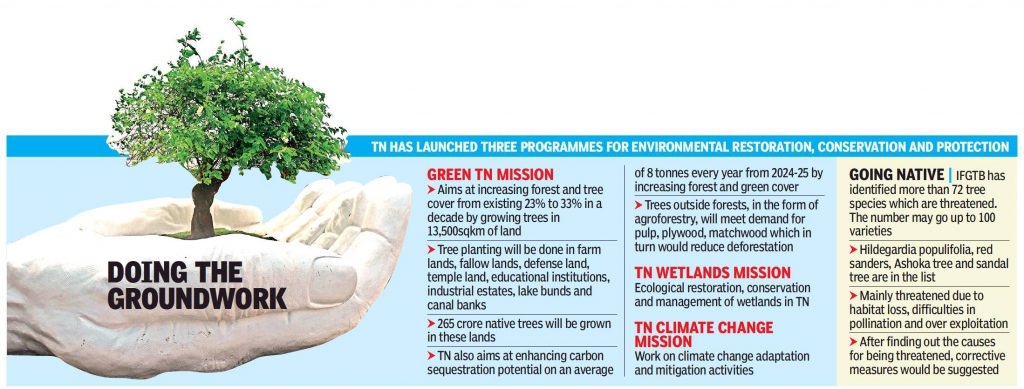GETTING TO ROOT OF AFFORESTATION PLAN
Land Issues, Tree Variety Suited To Soil Are Some Of The Challenges For State

The Tamil Nadu government unveiled its most ambitious afforestation project a few days ago to plant 265 crore seedlings across the state over the next 10 years. Called Green Tamil Nadu Mission, the project aims to increase forest cover from 23% to 33% by 2030. This year 47 lakh seedlings are to be planted, for which ₹21 crore has been allotted. Next year it’s going to be 130 seedlings.
There is palpable cheer among the environmentalists. It’s a unique project, different from the afforestation programmes of the past. “Usually, fast growing trees will be planted which in most cases will be exotic species. This time it has been specified that only native species shall be planted,” says environmentalist Osai Kalidas. “Another crucial aspect is the government says the mission would be implemented with people’s participation,’’ says Kalidas.
But the task is easier said than done. Challenges await the government in implementing the project. To start with is the issue of identification of land. The government has said that 265 crore trees would be grown in 13,500sqkm land. Of this 4,500sqkm are degraded forests where the government can go ahead with planting. But for the remaining area, the government should bring several stakeholders on the same page from educational institutions to industrial bodies as well as government departments.
Departments of agriculture, forests, horticulture, highways, education, industry and public works department have a role since trees have to be grown on farmland, forests, along highways, in educational institutions, industrial areas and along water bodies. “Inter-departmental coordination is a challenge, but crucial for the seamless implementation of the mission,” says a senior government officer.
The key challenge is nurturing and protecting the saplings. “Tree planting is different from tree growing,’’ says principal chief conservator of forests Shekar Kumar Niraj, a member of the Tamil Nadu Green Climate Company formed by the government for the purpose.
Planting is easy, but protecting and raising saplings is a different ball game, says Niraj. Saplings have to be protected for at least three to four years, especially those planted in public areas. “Continuous monitoring is required,” he said. Saplings have to be protected from cattle, tree guards should be placed and they have to be watered regularly.
T R Sivaram, founder of Vetry and managing director of Classic Polo, says choosing the right species is the key challenge. “We are planting two lakh trees every year. We have GPS coordinates of the plantations and a detailed database of the trees we have planted.” When we started they planted ‘neer maruthu’, meant for riverside, it was the first failure. “Another species we planted was ‘mul moongil’. It attracts a lot of rodents which in turn bring reptiles. Similarly, ‘malai vembu’ was suggested as a fast growing tree. But the rapid growth was only for the first two years, after which it was stunted,’’ Sivaram says. “Some species will take a long time to yield like rosewood. Farmers will not get dividends from growing this tree as no permission is granted to fell it,’’ he says, explaining the lessons they learned.
Osai Kalidas says a lesson or two can be taken from Vanathukkul Tirupur, a mass transplantation project initiated by Vetry, an NGO. Vanathukkul Tirupur started with one lakh saplings in 2015 to pay homage to late President Abdul Kalam and has so far grown 12.5 lakh trees across Tirupur. Now several industrialists and about eight NGOs participate in the plantation drives.


Proposal to save native trees
Institute of Forest Genetics and Tree Breeding (IFGTB) has prepared a proposal to be sent to the Union ministry of environment, forest and climate change to save threatened tree varieties inside and outside forests.
Some of the tree varieties are threatened due to various reasons such as habitat loss, difficulties in pollination, limited distribution or over exploitation. These tree species can be brought into the green list from the present red list once their numbers are increased.
Director of IFGTB C Kunhikannan said the ministry had given the mandate to come up with a plan to preserve the threatened tree varieties. “We have listed out more than 72 trees including hildegardia populifolia, which is known to exist only in Kalrayan hills. There are also other tree varieties such as red sanders and Ashoka tree. The list may extend up to 100 varieties,” he said.
Once accepted, scientists from the institute will start working with other agencies such as the forest department to improve numbers of trees in the regions under its ambit such as Tamil Nadu, Kerala, Puducherry and the Andamans Islands.
Kunhikannan said field visits would be conducted to find out causes for the tree varieties being threatened and propose measures to improve their numbers. TNN
V.Mayilvaganan@timesgroup.com
Link: https//timesofindia.indiatimes.com/city/chennai/getting-to-root-of-afforestation-plan-in-tamil-nadu/articleshow/88429955.cms: